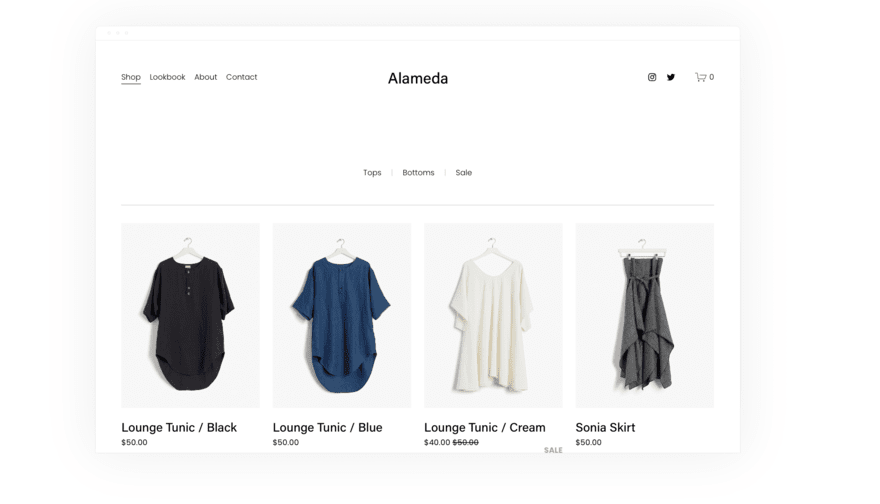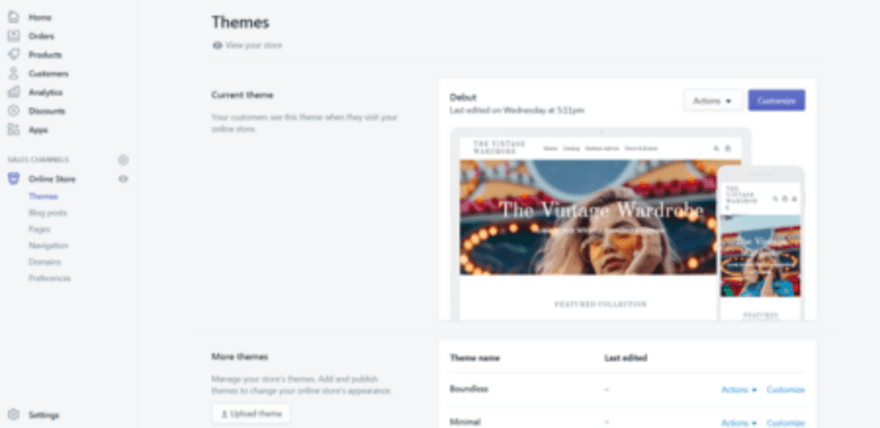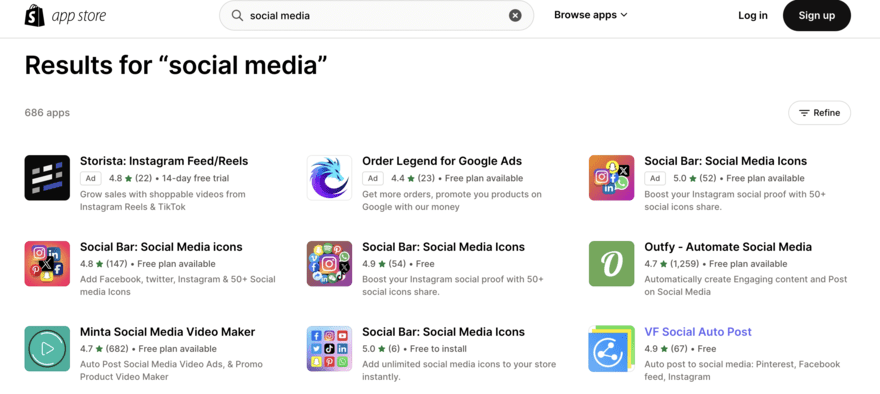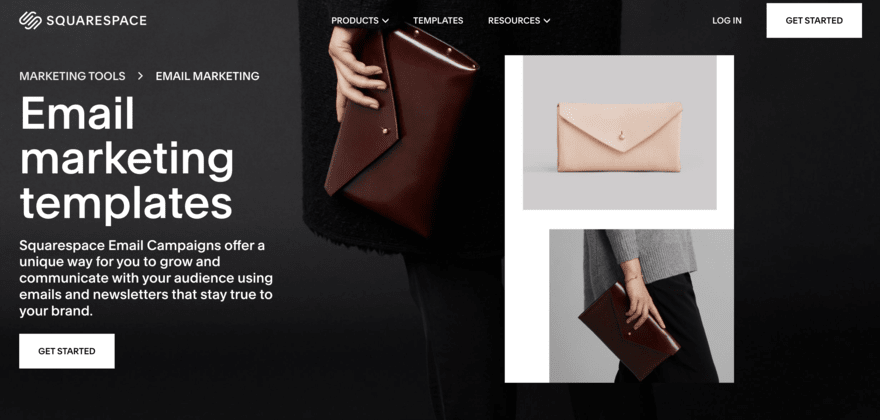How to Start an Online Clothing Store | Step-By-Step Guide
If you click to purchase a product or service based on our independent recommendations and impartial reviews, we may receive a commission. Learn more
In this guide, we’ll take you through every step of how to start an online clothing store, all the way from finding your niche to building your online store. We’ll even show you how to optimize your store so customers can easily find it on Google!
One of the most important steps is to choose your ecommerce builder. Our in-depth testing places Shopify as our top choice, since it’s easy to use and has everything you need to manage a large inventory.
Making a success of your online clothing store is tricky in a competitive market, but if you follow the simple steps below, you’ll be well on your way to selling in a matter of hours.
Tools You May Need
Here’s a list of tools you’ll need to build your online clothing store. Some are essential, but you may find others useful, too.- A website builder – this is the platform you’ll use to build your online store.
- Brand content – product information, a store bio – you’ll use all this to make your online store unique.
- Product photos – make sure to use high-quality images to show your products off to their best advantage.
- A domain name – using a personalized domain name will cost you a bit extra, but it’ll make your store appear more professional.
- Branded social media accounts – perfect for marketing your online store when it’s all set up!
1. Choose a Clothing Niche
First things first, you need to choose your clothing niche.
With SO many online retailers selling clothes, you need to figure out your own USP, what will make you stand out from the crowd?
When deciding on your clothing niche, you need to ask yourself:
- What types of clothing interest you?
- Is there a market for your clothing niche? How competitive is it?
- Who would buy the clothes?
- Is there demand for the clothing style you want to sell?
Some examples of clothing niches to help inspire you include:
- Plus size clothing
- Vegan clothing
- Vintage clothing
- Children’s clothing
- Handmade clothing
- Themed clothing
- Sustainable clothing
Not only do you need to determine the type of clothing you want to sell but also what will make your overall business stand out from the crowd e.g. offering high-quality clothing at accessible prices or offering a limited amount of each item for a tailored service.
Find Out More
- Learn more tips on How To Find Your Niche in our full guide
- Discover our take on the Future of Fashion for trends to consider in the industry
2. Source Clothing Suppliers
You need something to sell from your online clothing store which is why you’ll need to source a clothing supplier.
A clothing supplier will supply you with the clothes you want to sell to customers. Of course you can design the clothes you sell from scratch but if you would rather purchase from a supplier, there are various options available for you.
Online directories – Directories such as Alibaba and FashionTIY have hundreds of thousands of items to choose from.
Trade Shows – Trade shows give you the opportunity to see and feel the clothes in person, giving you a strong sense of quality.
Referrals – If you have existing contacts in the industry, you can ask other clothing stores for referrals to their clothing suppliers.
Remember, when you’re choosing a clothing supplier you need to consider:
- Product quality
- Product price
- Minimum order quantity
- Shipping terms
- Payment terms
3. Test & Choose Your Online Store Builder
Ecommerce website builders let you start selling online for just a small fee.
You’ll need to sign up to an ecommerce plan to connect to payment processors allowing you to take payments from customers when you start selling clothes online.
As well as being easy and economical to use, online store builders will also take care of all the technical stuff so you don’t have to.

You can start selling clothes online in no time without having to worry about security upgrades and hacking risks. Online store builders also give you an SSL certificate.
SSL certificates provide secure, encrypted communications between your website and your customers’ internet browser. This means that all credit card transactions and data transfers are safe and secure.
Having an SSL certificate is like having security tags in all your clothing to prevent shoplifting, except you don’t have to install or maintain them!
Online store builders take care of this for you so your clothing store will be safe from hackers – the internet equivalent of shoplifters, although they’re looking for data, not clothes!
But which builder should you choose? With so much choice, it can be difficult to know where to start.
This is where we come in to help you figure out which is best for your needs. Here’s a run-down of our top-rated online store builders:
- Shopify – best overall online fashion store builder. Standout strength: sophisticated inventory system
- Wix – best for inventories of eight products or less. Standout strength: ease of use
- Squarespace – best for brand-focused stores. Standout strength: award-winning templates
Below you can compare each platform’s ratings to get a better idea of their strengths and weaknesses:
Over the years we have tried and tested many different builders through starting our own businesses. This has helped us to build up some great resources that aspiring entrepreneurs – like you! – might find handy.
We recommend Shopify as the best overall online store builder, because of its powerful inventory system and ease of use. Its huge app store is also a major asset when it comes to growing your store in the long term. However, it’s not right for everyone.

Wix, on the other hand, is much better for smaller stores. Not only does it come with tons of ecommerce features, and good inventory management for a reduced stock list, it’s excellent value for money, too. Plus, it’s so easy to use, practically anyone can give it a go!
If you’re brand-conscious and care about your storefront’s design, then Squarespace is your perfect choice. It has award-winning template designs that will really show off your products, paired with a great inventory system and cheap starting plans.
Besides its ecommerce offering, Squarespace has also made massive improvements to its UX in recent years, resulting in a huge jump from its previous 3.4 ease of use score to a brand new shiny rating of 4.2 out of 5. This makes it the easiest builder to use out of the four we’ve listed.
If you’re struggling to settle on an online store builder, the best way forward is to test a couple of builders.
When you’re trying them out, think about asking yourself the following questions to help you come to a decision:
Which Platform Are You Most Comfortable Using?
- Do you find the interface intuitive and simple to use?
- Can you easily add new pages and products?
- What support is available if you get stuck?
Which Builder Has Templates and Design Features That Help You Create the Clothing Store You Want?
- Are there a wide variety of templates for you to test out?
- Will the templates showcase my products in a way that I like?
- How much creative freedom does the editor give you to personalize your store?
Ultimately you want a builder that makes it quick and easy for you to set up an online clothing store and get selling!
Further Reading
Ecommerce Comparison Chart – we compare five online store builders to help you come to an informed decision about which best suits your needs.
Shopify Review – where we delve into all things Shopify
Wix Ecommerce Review – an in-depth review of Wix’s ecommerce capabilities
Squarespace Ecommerce Review – we’ll explore how Squarespace can help your ecommerce business
4. Decide which Plan Is Best For You
Online store builder premium plans, like most things in life, tend to get better with the more you spend. The more you pay the more storage and templates you’ll have access to.
When we say storage we’re not talking physical storage like a warehouse, we’re talking data storage. The more storage you have, the more images, videos and other media you can host on your website.
Extra storage is useful for expanding your product range, increasing the number of angles customers can see products from or adding product videos.
When you’re able to host more products and show them off in more of a range of ways (angles and videos) your sales will increase and boost your bottom line!
With access to more templates, you’ll be able to pick one that really suits the tone, style and character of your online clothing brand. It’s like finding a pair of jeans that fit perfectly – worth paying a bit extra for!
With a paid plan, you’re also able to get rid of the builder’s logo and connect a custom domain name to truly give your online store its own, unique personality.
Your store address will no longer be www.theclothingco.mybigcommerce.com, it will be www.theclothingco.com.
A custom domain name makes your online clothing store look more professional and reputable. This, in turn, builds up trust around your brand which will ultimately incentivize sales.
But how do you know which plan is best for you? It’s best to take into consideration what we’ve mentioned above, and also check out the table below.
You don’t always have to pay high prices for high-quality selling tools. If you’re working to a budget, Wix and Squarespace offer the best value for money. If you only need to sell a few products, you can get started with Squarespace for just $23 per month – its fully equipped ecommerce plan costs $27 per month. Wix’s cheapest ecommerce plan costs $29 per month and comes with an impressive ecommerce offering. You don’t have to break the bank to sell online!
This table compares the basic and advanced plans of our top ecommerce platforms:
| Website Builder | Ecommerce Plan Starting Price |
|---|---|
| Shopify | $29 per month |
| Wix | $29 per month |
| Squarespace | $23 per month |
If you like what you’ve seen so far, but you’re still not sure which builder is best for you, we’ve got some good news: you can try Shopify, Wix, and Squarespace for free. This means you can work out which is best for you before committing to purchase!
Further Reading
Shopify Pricing Plans Review – take an in-depth look at Shopify’s prices
Wix Pricing – all you need to know about Wix’s pricing plans
Squarespace Pricing Review – learn about Squarespace’s plans and value for money
How Much Does a Web Site Cost – The Definitive Price Guide, as to exactly how much building a website costs
5. Choose Your Domain Name
If you want to add a professional touch to your online clothing store, a custom domain name is the way to go. The more professional your store looks, the more likely people are to buy your clothing range.
A unique domain name gives your clothing store an identity online. Think of it like the zip code of a brick and mortar store – it identifies where you are and helps people find you easily.
In the URL for this page www.websitebuilderexpert.com/how-to-start-an-online-clothing-store, websitebuilderexpert.com is the domain name.
To purchase a domain name, you can either go directly through your online store builder, or you can purchase your own through well-known domain name registrars such as Domain.com.
Wondering which option is best? Buying a domain name through your online store builder may be easier in the short run, however if you ever leave that builder (e.g. if your online clothing store becomes too large for the one you were using), taking that domain name with you is pretty tricky.
Purchasing it through a third party may take slightly longer in the short term but is much more versatile in the long run.
If you would like more information, take a look at our guide dedicated to domain names.
Choosing a domain name can be tricky if you don’t yet have a company name for your online clothing store. First think of a company name and your domain name will evolve naturally from there.
Try and think of something catchy, not too long or wordy, and nothing too similar to an existing major brand. Try and name your company something that reflects your products or the ethos of your brand.
6. Choose Your Template
Choosing a template is the really fun part. It enables you to create the storefront that you dreamed about so you can really hit the ground running with your customer.
You can create a beautiful and professional online clothing store in seconds thanks to the professionally designed templates available from all the builders, and you don’t need to learn that foreign language of code to do so!
Your template determines the look and feel of your online store, so making the right decision is important. Of course, you can customize your template after having chosen it, but your choice does form the basis of your store’s design.
Not sure which template to use? We recommend testing out a few first before making a definitive choice.
“Previewing a template is just like trying on a new outfit. If you don’t like it, or aren’t 100% sure, get changed and start again.”
Try and have your customer in mind when choosing your template. If you’re not sure who your target audience is, ask yourself these questions:
Who Are My Customers?
- How old are they?
- What do they do in life?
- How much do they earn?
- What kind of lifestyle do they lead?
Once you have your customer in mind, choosing your template will be much easier. Put yourself in their shoes, think about what they would want to see from your online clothing store and try to replicate that as much as possible with your template choice.
Although it’s important to focus on your customers, you’ll also want to give your store that personal touch, so don’t lose sight of your vision either.
Choosing a template is a balancing act, you’ve got to juggle the online clothing store you imagined with the one that will best suit your customers’ needs.
Most online store builders have an impressive offering regarding the templates they offer related to clothing and fashion. For more info, we’d recommend browsing our guide to the best fashion templates on the web to get you going.
Squarespace leads the race for design in first place. In this category, the builder scored 4.1 out of 5, making it the best choice if aesthetics is a top priority for your clothing store.
Squarespace has a reputation for its beautiful templates. There are over 100 to choose from, around six of which are specifically for online fashion stores. However, you aren’t limited to this small selection. All of Squarespace’s templates can be customized to make your products shine.

Squarespace’s stylish templates are perfect if you’re a brand-conscious store owner and want an attractive storefront. Its designs are clean and modern, and feature a lot of white space to really showcase your products. You’ll need high-quality product images to match its stylish, image-focused designs.

Wix has over 800 templates in total, with 31 specifically designed for online clothing stores. They’re mostly stylish and modern, although there are a couple of less attractive options, something that is reflected in Wix’s lower design score of 3.5 out of 5.
Shopify has 67 designs in its “Clothing & Accessories” category but you have to pay for most of its templates. There are eight free templates, and the rest cost upwards of $150 to buy.
If you choose to purchase a theme, though, you won’t be disappointed. Shopify came second in our ratings with a design score of 3.7 out of 5, mostly thanks to how attractive its designs are and the customizability potential that goes with them.
Of course, you aren’t limited solely to the templates suggested by online store builders for clothing or fashion specifically. You’re free to choose from any of the hundreds of options they each have.
Choose the right template to make a great first impression on customers and increase your sales.
7. Customize Your Template
To really personalize your online clothing store, you need to customize your template. Don’t worry, this is super easy to do and doesn’t require you to know how to code at all!

You Can Customize Your Template By:
- Adding new pages e.g. product pages (which we’ll go into in more detail in the next step)
- Adding a blog where you can publish news pieces or updates
- Changing the color palette and background image of your template
- Moving, adding and removing different elements on each page
- Changing the color, size and font of different sections of your online store
- Integrating your social media feeds with your store
The online store builders’ interfaces are all very intuitive and easy to use, so there’s no need to feel overwhelmed when customizing your template.
Remember, you’re responsible for designing your online store. This means you won’t face the same design compromises you’d face when hiring a professional designer.
In fact, being able to stay true to your initial vision is one of the main reasons why we fell in love with building our own websites in the first place!
Just like choosing your template, when you’re customizing it, make sure you really think about your target audience. Try and get into their mindset and design your online clothing store accordingly.
When customizing your template, it’s really important to make sure you check out how it looks on mobile and tablet devices too.
Nowadays, more internet searches are performed on mobile devices rather than the traditional desktop
Over 57% of internet traffic comes from mobile devices. So having an online clothing store that looks good on mobile is a must. Most builders make it very simple to preview the look of your store on devices other than a desktop.
Wix has its own mobile editor that allows you not only to see what your store looks like on mobile, but to make changes if you’re not happy with it. Those changes will then only apply to the ‘mobile ready’ version of your site, while the desktop version remains as it was.

You might now be thinking that this all seems too complicated and that it might be easier to just hire a web designer to handle it for you, but unless you’ve got a pretty big budget you may want to reconsider. Plus, we think that customizing your store to reflect your own unique brand is the best bit!
Customizing your template is your chance to optimize your store for your customers so you can increase your all-important bottom line!
8. Add Products to Your Online Store
Your product pages are the most important part of your online clothing store, after all, this is where you can convert window shoppers into paying customers!
While your homepage functions as the digital equivalent to your brick and mortar storefront, your product pages are the online version of the shop floor.
And adding products couldn’t be easier. With Shopify, add products by going into the product tab on the left-hand side of the Shopify editor and then by clicking on the blue ‘Add product’ button on the top right hand side.
It’s important to bear in mind your customers when customizing product pages. If you make them too busy then you may give people choice paralysis. If it’s too sparse, customers won’t have any choice at all.
You need to ensure that customers can find what they need quickly and easily. Anything else is bad design!
When thinking about how best to showcase and sell your merchandise online, we recommend asking yourself: Who do my customers currently buy from?
Then research these stores by looking at how they show off their products, how they entice customers and how they encourage them to make a purchase.
Things To Look For When Analysig Competitors’ Product Pages Include:
- Are their products displayed in grid or list format?
- How many products are displayed per page?
- How are their products grouped?
- Are you able to sort products by price, bestselling, featured?
- Can you filter products by color, material, brand?
Think of it like seeing someone on the street wearing a really great outfit. You’d be inspired and want to try and replicate it, all the while putting your own spin on it, right?
Further Reading
If you want more information about designing your product pages head over to one of these guides:
Ecommerce Product Page Design – our guide to designing a winning product page
Or, if you want more builder-specific information, check out these:
How to add products on Shopify
How to add products on Wix
Need some inspiration? We interviewed Simply Preloved Children’s Boutique about running a clothing business.
9. Set Up a Payment Processor
Setting up a payment processor is no harder than the rest of the online store building process, if you’re feeling worried about it, you really don’t need to be!
In order to start making money selling clothes online, you will need to connect a payment processor to your store. Payment processors are services that allow you to take credit card payments from your customers.
If you’re using Shopify, it has an integrated payment processor called ‘Shopify Payments’ (in conjunction with Stripe) that allows you to manage your payments directly in its user dashboard. This means you can track your money in real-time. Plus, it’s really easy and means you won’t be charged any transaction fees, either!
Shopify also supports a huge number of other payment processors and gateways – 100, to be exact! You’ll find all of the big names on there, like PayPal and Amazon Pay, as well as some smaller ones, too.
Wix also has its own in-house payment processor, called Wix Payments, and also supports an additional 10 other payment gateways, including PayPal.
Squarespace supports a wide range of payment options for you to choose from, although not as many as Shopify and Wix. Squarespace primarily lets you accept payments via Stripe, PayPal, and Square. Setting any of these can be done in a few clicks.
If you get stuck setting up a payment processor, most online store builders have impressive support centers or forums where you can find all the information you need.
We recommend running a test order when setting up payments. This allows you to get a feel for how your customers will progress through the checkout stage so that you can make any changes and improvements.
“You want to make sure the checkout process is as seamless and easy as possible so that you don’t lose any customers at this late stage of the buying funnel. An easier checkout means more sales and higher profits!”
Further Reading
Builder specific payment information:
Shopify Payment Help
Wix Payment Help
10. Get Your Clothing Store Found Online
Selling clothes online is a competitive undertaking. In order to attract customers to your online clothing store (and away from the competition), you will have to get found on search engines.
This means that you need to think about optimizing your store for search engines. First of all you’ll want to have a keyword focused page title and meta description.
Your page title is the blue link you see in the search results and the meta description is the text underneath it that gives you an insight into what that page is about.
Keywords are what people search for to arrive at your online clothing store. They are terms that are related to what is on your online store.
For example, if you’re selling women’s vintage clothing and accessories, your keywords might be: ‘vintage clothing,’ women’s vintage clothing’ ‘vintage accessories,’ and ‘women’s vintage accessories.’
To show Google that your store is relevant to those keywords, you will need to use them in your page title and meta description.
Another thing you’ll want to do is make sure your site is structured in a way that Google can find all of your content.
This will help your store to appear in more search results. It also has the added benefit of helping your customers navigate quickly and easily around your store.
For example, if someone searches ‘blue denim jacket’ then having good site structure might make your blue denim shirt product page rank in search engine results pages (SERPs) because your homepage more than likely won’t.
This is because it is not tailored to this specific search term as it is more of a general page (not specifically about blue denim jackets).

A logical site structure improves visibility to Google, which means more traffic to your site and ultimately more profits.
To do this make sure your pages link to one another, for example have a link back to your home page from your product pages.
This not only makes Google happy, but will keep your customer happy too as they can easily navigate around your store. And we all know the saying: ‘a happy customer is a loyal customer,’ so your SEO strategy isn’t only gaining new customers but is helping to turn them into returning ones.
Online store builders often hold your hand through the SEO process, but we’ve found Wix to be particularly good at this. Wix has its own SEO Wiz that creates a tailor-made SEO plan for you.
Squarespace also provides an incredibly in-depth SEO checklist in its help center. It’s not quite as beginner-friendly as Wix’s SEO Wiz, but it is an amazing resource for helping optimize your store.
“Online store builders rarely leave you to your own devices, they often have exhaustive help centers to see you through setting up your ecommerce site.”
Further Reading
Online Store Builder SEO – our detailed discussion about online store builder SEO capabilities
Check out each builder’s SEO help centers:
Shopify SEO
Wix SEO
11. Preview & Publish Your Online Clothing Store
Previewing your store is like having a quick look in the mirror before you leave your house in the morning. No-one wants to spend the day walking around in a back-to-front or inside-out t-shirt.
After creating, customizing and optimizing your online store, you’re probably feeling more than a little impatient about starting to sell your clothes online right? But take a step back for a second, you need to preview and test it first.
It’s important to check that your store looks exactly the way you want it to. More importantly, you need to make sure that everything works seamlessly to ensure a good user experience so that you sell as many clothes as possible.
We recommend you ask a friend or family member to help you preview your store, as after building it and staring at it for so long, you may have missed some silly little mistakes.
12. Market Your Online Clothing Store
Marketing your online clothing store is a crucial, and ongoing, step if you want to grow your customer base, increase customer loyalty, and stay ahead of the competition. Usually, a multi-pronged approach is best when it comes to marketing. You don’t want to be totally reliant on just one method!
Market on Social Media
Getting your store up and running is the first step, but in order to make sure you start (and continue) selling clothes online, you will need to market your store.
We recommend marketing your online clothing store on social media. This is a free and easy method of getting your brand name out into the world.
You could simply give your customers the chance to like your business on Facebook or to follow you on Twitter which means they can keep up with all brand updates, industry news you might share and any upcoming deals. This also helps you grow your brand and build up trust with your customers.
You could also integrate your social feeds directly into your online store.
Imagine showcasing your Instagram feed on your store – what a great way to show real-life examples of your clothing line and give your customers more reasons to make a purchase!

Use Apps to Expand Your Marketing Potential
Shopify and Wix both have extensive App Markets that allow you to extend the functionality of your online store. For example, you can integrate your social platforms with your online store. Squarespace has a slightly smaller library of app integrations, called Squarespace Extensions, but this is because it includes more in-house features so doesn’t need as many extra add-ons.
You can use apps to add helpful features such as visitor analytics and methods of gathering customers’ email addresses for marketing campaigns.

Use Email Marketing
Online stores in particular can make good use of email marketing apps and plugins. After all, you’ll have collected your customers’ email addresses when they made a purchase, so you have a ready-made audience of people to market to! You can send updates and promotions that will help you drive more sales.
A lot of online store builders come with email marketing software built-in. Squarespace, for example, has beautiful email marketing templates to align with your on-site branding when you use its email marketing tool Squarespace Email Campaigns. You can send 500 emails per month for $5 per month.
Or, alternatively, you can turn to apps to help you out. Shopify has a number of email marketing apps to choose from, whilst Wix integrates with Mailchimp.

Start a Blog
Another marketing method you could think about is blogging. Most builders allow you to add a blog to your online store very easily. You can publish thought leadership pieces, really display brand personality, and build a loyal following. Blogs can create a trusted brand name and help to boost your sales through repeat business.
Blog content is also a great thing to share on social media or to promote via email marketing – it all ties in together! This helps to truly establish your brand as a legitimate, trustworthy contender in the ecommerce retail space. Although all of our top four online store builders come with blogging functionality, Squarespace has the best blogging tools. Wix follows in a close second, with Shopify bringing up the rear.
With these easy, effective, and inexpensive marketing methods, your online clothing store will be making big bucks in no time at all.
Further Reading
Take a look at each builder’s App Market to help promote your store and so much more!
Shopify Apps
Wix Apps
Success Stories
To show you it’s not impossible to chase your dreams, check out some clothing stores created with online store builders whose clothes are flying off the virtual shelf!
Flatspot
Flatspot is an independent skate store and an industry leader in men’s contemporary fashion and street-wear. Their store is powered by Shopify, through which they sell 15 different types of clothing, from caps to sweatshirts and bags to trainers. Their products come from 35 brands and they now ship those products worldwide.
FlatSpot Gallery
Beacha Swimwear
Beacha Swimwear is a company founded by a team of three who decided to design swimwear that suited a particular niche in the market – making comfortable and attractive swimsuits for all body types.
Their success just goes to show that there is space for everything online – no matter how niche an idea is! They power their online clothing store with Wix where they are able to showcase a catalog of around 50 products and host video content.
Their store is elegantly presented reflecting the elegance of their swimwear and has clear call-to-actions to encourage purchase, making for a good user experience that converts!
Beacha Swimwear Gallery
Sadie Williams
Fashion designer Sadie Williams used Squarespace to create her website, which she uses to showcase her collections, sell products, share her projects, and display her portfolio and experience, as well as giving people the chance to contact her.
Sadie created the site to showcase her work and share her vision so that visitors can understand her brand identity. Here’s a snippet from an interview with Sadie, taken from the Squarespace website:
I have a website to showcase my work and get my vision across. I want people to understand my brand identity and how I use colors, textures, and fabrics. I can just update it whenever I have a new season collection or news.
Sadie William’s website makes full use of Squarespace’s visual templates – full-screen images and video backgrounds create an immersive user experience. This type of unique, creative approach is easy with Squarespace’s flexible design layouts. We especially liked the large product images!
Sadie Williams Gallery
How to Start an Online Clothing Store: Summary
Thanks to drag-and-drop online store builders, like Shopify and Wix, you’re able to sell clothes online without needing to know how to code and without breaking the bank.
Think of using an online builder in the same way you’d think about making your own shirt or blouse.
There is an investment of time, rather than money, and you can make it in exactly the style you want rather than having to conform to something made by someone else (a website designer) that doesn’t fit quite right, and that you’ll have to pay even more to correct.
Once you’ve chosen your website builder and customized your website, you can promote it online to drive traffic to your site that will hopefully convert into customers.
Start your online clothing store today by signing up to one of these free trials:
- Try Shopify for free
- Try Wix for free
- Try Squarespace for free




51 comments